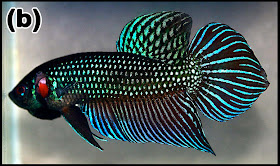Fighting Fish (Bettas) are colourful members of the Gourami Family (Osphronemidae) popular in the aquarium trade and noted for their aggressive nesting behavior. In the wild they live in rice paddies and similar environments, where the males build bubble-nests from sticky oral secretions containing air bubbles, typically anchored to some sort of plant. The females lay their eggs in these nests, which the males then defend these nests against other males and any other perceived threats (the Thai name for the Fish, Plaklad, translates as 'Biting Fish').
In a paper published in the journal Zootaxa on 19 October 2012, Chanon Kowasupat of the Institute for Innovative Learning at Mahidol University, Bhinyo Panijpan and Pintep Ruenwongsa of the Faculty of Science at Mahidol University and Namkang Sriwattannarothai also of the Institute for Innovative Learning at Mahidol University describe a new species of Fighting Fish found nesting in Nipa Palms (Nypa fruticans) in Samut Sakhon Province, Thailand.
Nipa Palms are a form of Mangrove; trees which can tolerate immersion in salt water, and which colonize tidal flats and salt marshes, forming unique habitats. The Palms trap pools of water at the bases of their leaf stems, similar to the pools of Bromeliads, and it is in these pools that the new species of Fighting Fish nests. The population has been known of for some time by fish enthusiasts, and there has been some prior speculation as to whether they were a separate species, or a population of the more widespread Splendid Fighting Fish, Betta splendens.
(a) A Nipa Palm stand in Samut Sakhon Province, Thailand. (b) Water pockets at the base of the leaf stems of a Palm, with Fish found within one of the pockets inset. (c) The Fish inside the pocket, with a bubble-nest to the right. Kowasupat et al. (2012).
Kowasupat et al. have now confirmed this Fish is a separate species, based upon both morphology and DNA analysis. They name it Betta mahachaiensis, after Maha Chai, where the Fish were first noted and where the suspicion they might be a separate species began. It was found at a number of sites in Samut Sakhon Province, west of Bankok. These sites are not pristine natural environments, they are disturbed by human activity (Nipa Palm is used as a roofing and basket-making material as well as an animal feed, and Arrack, a form of palm-wine, is made from its sap), and all are threatened by expansion of human settlements into the salt-marshes where they occur, suggesting that Betta mahachaiensis, is under threat from human activity. The area has also recently become prone to flooding with fresh-water, something which both the Palms and the Fish can tolerate, but which brings larger predators into the marshes.
(a) Map of Thailand showing the area where Betta mahachaiensis was found (rectangle). (b) Expanded map of the inset area, showing sites where Betta mahachaiensis and the related Betta splendens were found. Kowasupat et al. (2012).
Betta mahachaiensis is a 120-140 mm Fighting Fish, black or brown with iridescent green or bluish-green scales. The males are considerably more conspicuous than the females.
Betta mahachaiensis; (top) male & (bottom) female. Kowasupat et al. (2012).
See also A Flying Fish from the Middle Triassic of Guizhou Province, China, To cull or not to cull? The Goliath Grouper in Floridan waters, A new species of Pufferfish form French Polynesia, A new species of Cichlid Fish from Lake Tanganyika and Boney Fish on Sciency Thoughts YouTube.
Follow Sciency Thoughts on Facebook.




